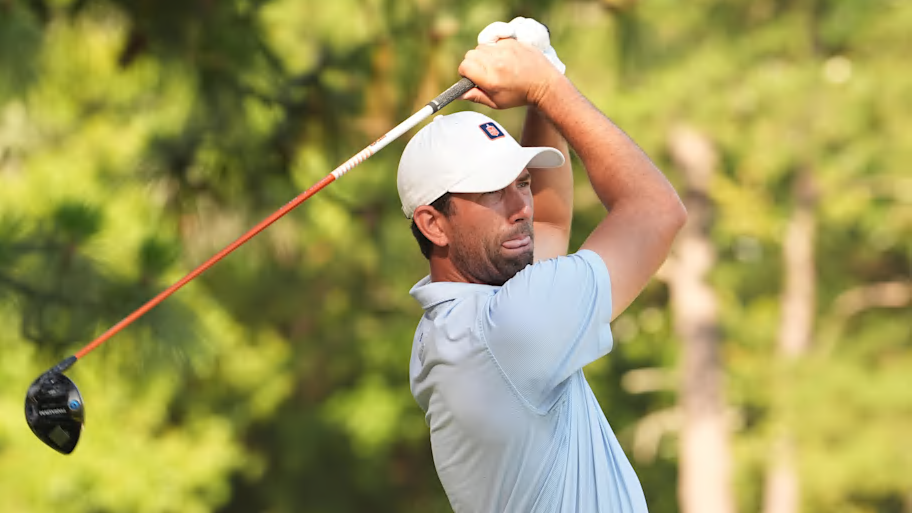According to the USGA’s website, the U.S. Mid-Amateur was originally created in 1981 because, “the post-college player found himself at a disadvantage in the U.S. Amateur.”
Forty-four years later, it may at first seem like the post-college-never-played-pro-golf player is at a disadvantage at the U.S. Mid-Am. But in this case, appearances are deceiving.
This year, seven of the eight quarterfinalists at the U.S. Mid-Am played professionally before regaining their amateur status. Both of the players in this year’s finals, Brandon Holtz and Jeg Coughlin III, previously played professionally. Coughlin reached the second stage of the PGA Tour Q-School as an amateur last fall.
Last year, the Mid-Am final also featured two former pros: 2024 U.S. Mid-Am champion Evan Beck, who played four years of pro golf before being reinstated as an am in 2019, and Bobby Massa, who played five years of pro golf.
This year, both advanced to the quarterfinals along with Christian Brand, who made 67 career Korn Ferry Tour starts, and Justin Hueber, who made 87 starts on the KFT. Coughlin, Parker Edens and Brandon Holtz were also former playing pros who returned to amateur status and made the quarterfinals.
The only player who made the quarterfinals while never turning pro is Christian Cavaliere. After college he founded Tremont Sporting Co., a premium custom golf goods brand which he still runs full-time. He played at Boston College and considered turning pro, but instead decided to focus on Tremont. He lost in the Mid-Am semifinals to Holtz.
Despite the sudden influx of former pros succeeding at the Mid-Am, the USGA doesn’t believe this is an issue.
“We recognize that each reinstatement decision we make can have an impact at all levels of the amateur game,” Adrian Godoy, manager of championship communications for the Mid-Am, told Sports Illustrated via email. “For that reason, the USGA regularly reviews its decisions when determining the length of time an applicant for reinstatement must wait before regaining their amateur status.”
Recent history at the Mid-Am supports this not being an issue. Stewart Hagestad never turned pro and won this event three times, including in 2023 and 2021. In between, Matthew McClean, an optometrist in the U.K. who never turned pro, won in 2022. Lukas Michel, the 2019 champion, also never turned pro. The 2020 Mid-Am was canceled because of the COVID-19 pandemic.
Much has changed in the last few years, however, and alarms should be ringing—not for the Mid-Am, but for the overall professionalization at the top of the amateur game.
In 2021, the USGA changed the rules to allow amateurs to accept compensation for use of their name, image or likeness (NIL payments). That provided financial means for young players to professionalize their amateur careers, and the results speak for themselves.
Jackson Koivun is a junior at Auburn who has NIL sponsorship deals with Titleist, FootJoy, Foresight Sport and an investment advisory company called Betterment. He has played in six PGA Tour events this year with three top-10 finishes, a T11 and no missed cuts other than the U.S. Open.
Nick Dunlap, the 2023 U.S. Amateur champion, won the 2024 American Express, becoming the first amateur to win on Tour since Phil Mickelson in 1991. He turned professional shortly after and won again, though he struggled this past season.
Mason Howell, the 2025 U.S. Amateur champion, is 18 years old and already has sponsorship deals with Ping, FootJoy, Titleist and Holderness & Bourne. He missed the cut at the U.S. Open this year and will play in the Masters and U.S. Open next year.
Yes, Howell and Koivun are still attending school, completing homework and studying for tests. But they’re also training like pros and have the financial support to do it.
Does that mean they shouldn’t compete in amateur events? Of course not. They earned that money. Does that give them a leg up on players who don't have the same sponsorship deals? Yes, of course. Both can be true at the same time.
The original spirit of the Mid-Am was to give great golfers who had to get regular jobs after college a chance to compete and earn entries into prestigious events like the U.S. Open. But the landscape of “amateur” golf has evolved so rapidly that the top ams are now able to practice and train like pros. Being upset at former pros who regained their amateur status and are now playing in the Mid-Am misses that point.
Golf purists may not like it, but the amateur game is professionalized already.
This article was originally published on www.si.com as The U.S. Mid-Amateur Does Not Have a Professional Problem.
